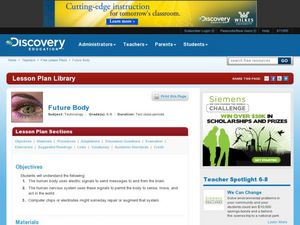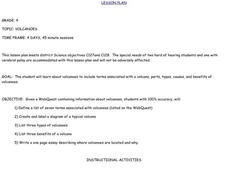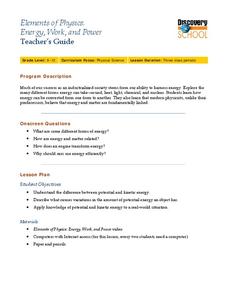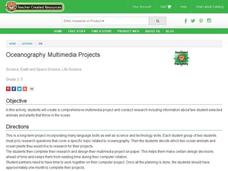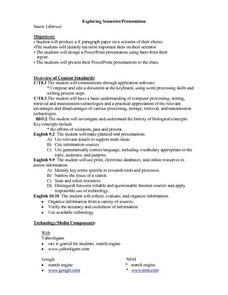Curated OER
Future Body
Learners explain the benefits of cyborg augmentation. In this technology lesson, students research how the nervous system works. They create posters and present them to class.
Curated OER
Our Savage Planet in the News
Pupils explore extreme earth phenomenons. For this savage planet lesson, students explore and report on various types of severe weather and earth phenomenons using the Internet, a word processor, or other multimedia device.
Curated OER
What's Matter?
Pupils explore the definition of matter. In exploring matter lesson students get into groups and navigate the Internet to answer questions.
Curated OER
Hide and Seek
Learners examine animals that use camouflage and discuss why they use it. They create drawing of an imaginary animal that uses camouflage to hide in the classroom and identify the adaptations that would allow it to hide effectively.
Curated OER
Ins and Outs of Simple Machines
Students explore the ins and outs of simple machines. They discover the various roles of simple machines, who uses them, where they can be found and how they actually work. Students create a compound machine using simple machines.
Curated OER
Genetic Vocabulary
In this genetics worksheet, learners compare structures of molecules, compare the function of genetic enzymes, and compare transcription and translation. This worksheet has 2 multiple choice and 20 matching questions.
Curated OER
BioKeys
Students identify insect (and plant) specimens using the online resource Biokeys. They record the data that they collect in their notebooks. Students use identification characteristics and features that are shared and unique among groups.
Curated OER
Meteor Monitor
Student's measure sporadic meteor activity. In this physics and astronomy lesson, 11th graders construct a dipole antennae, and build, test and wire a full wave diode rectifier between the dipole antenna and the laptop.
Curated OER
Volcanoes
Fourth graders complete a WebQuest about volcanoes. They study vocabulary, label diagrams, list volcano types and benefits. They write an essay telling where volcanoes are located and why.
Curated OER
The Grand Canyon
Fourth graders study the Grand Canyon. They research the Grand Canyon and locate the Colorado River on the map of Arizona. They discuss erosion and read how sedimentary rock was formed. They view photographs of the Grand Canyon and...
Curated OER
Potato Lab
In this osmosis instructional activity, learners put a strip of potato in three different solutions and document the changes in the potato to determine is the solutions were hypotonic, hypertonic, or isotonic. This instructional activity...
Curated OER
The Ice Age
Students study the differences in the Ice Age terminology and what causes them. For this Ice Age lesson students examine what plants and animals lived during the Ice Age.
Curated OER
Energy, Work and Power
Students examine the differences between potential and kinetic energy. In this physics lesson students view a video and apply what they learn about energy to apply it to real world situations.
Curated OER
Oceanography Multimedia Projects
Students examine marine life. In this oceanography activity, students design a multimedia project using PowerPoint or HyperStudio that encompasses research that they do on ocean ecosystems.
Curated OER
Exploring the Night Sky: Fall/Winter
Students explain how moon phases occur. They explain three ways that the night sky has been used through history. Students locate some of the constellations in the night sky. They discuss stories and myths surrounding stars.
Curated OER
Regulation - Human Nervous and Endocrine Systems
Young scholars explore homeostasis within the nervous and endocrine system with this Smart Board activity. For this biology lesson plan, students will fill in the know and want to know sections of a KWL chart as a class...
Curated OER
Heredity, Genetics, Traits
Eighth graders study how an embryo develops into a fetus by undergoing many physical changes which they observe on a poster. They examine the metamorphosis of fruit flies as they develop through a series of changes. They record the...
Curated OER
Investigation 8 - Weather Forecasts
Fourth graders examine how to predict and evaluate weather forecasts. Discuss with students why weather predictions are important to us. Ask them what people do after they hear a forecast. They brainstorm reasons forecasts are important...
Curated OER
Trouble in the Troposphere
Young scholars create graphs using NASA data, compare ozone levels of several U.S. cities, analyze and evaluate the data and predict trends based on the data, and discuss and describe how human activities have modified Earth's air quality.
Curated OER
GeoHunt
Students describe the difference between geological resources and othe natural resources. They list the rocks, minerals, and fossil fuels that are found in Illinois and their uses. They identify ways to conserve natural resources.
Curated OER
Exploring Scientists/Presentation
Learners research a scientist of their choice. They write a research paper on him or her. They select ten important facts from their research paper and prepare a PowerPoint presentation using their facts.
Curated OER
Inner Planets
Middle schoolers research characteristics of the planets and record their findings on Planet Web worksheet. They create fold paper to create a foldable booklet to display the information they discover about the planets.
Curated OER
Inner Planets
Young scholars create a booklet about the inner planets after researching the characteristics of each planet. Students research the following items for each planet: moons, size, rotation, orbit, atmosphere, an interesting fact. Their...
Alabama Learning Exchange
Researching the Oceans of the Earth
Fifth graders participate in a research project involving the oceans of the earth. They research with the help of the library and the Internet. They put their collected research into a folder, brochure, PowerPoint presentation and a...


